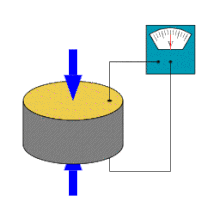Also on KRON Channel 4 the reporters did a story on BART (today's date is October 9, 2018)!! Since their already for the early warning system to stop the Trains in event of an earthquake I had an idea. Should BART drill a tiny hole near a third-rail straight down (think of the Oil Rigs that drill for oil) than use a (see picture 1) little wire with a sensor
at an appropriate depth BART may increase that warning system. An hour would be great should the sensor be reserved enough to hit that third-rail which you would attach in one or multiple locations with only a weld and or possibly a magnet (see picture 2). The sensor at the base would send a message directly to BARTs preparedness Center!!
The drilling would be easy as the bits could break all they want and due to the size of that tiny hole the retraction would not cause a problem especially since you would not know what type of material you would be drilling through to end it with a small cup that gave the sensors room enough to work. Possibly consider copper or plastic tubing to protect that fine wire for easy replacement, you know to keep an eye on that sensor and to be sure there would not be corrosion.
Piezoelectric sensor
A piezoelectric disk generates a voltage when deformed (change in shape is greatly exaggerated)
Contents
Applications
Piezoelectric sensors are versatile tools for the measurement of various processes. They are used for quality assurance, process control, and for research and development in many industries. Pierre Curie discovered the piezoelectric effect in 1880, but only in the 1950s did manufacturers begin to use the piezoelectric effect in industrial sensing applications. Since then, this measuring principle has been increasingly used, and has become a mature technology with excellent inherent reliability.They have been successfully used in various applications, such as in medical, aerospace, nuclear instrumentation, and as a tilt sensor in consumer electronics[1] or a pressure sensor in the touch pads of mobile phones. In the automotive industry, piezoelectric elements are used to monitor combustion when developing internal combustion engines. The sensors are either directly mounted into additional holes into the cylinder head or the spark/glow plug is equipped with a built-in miniature piezoelectric sensor.[2]
The rise of piezoelectric technology is directly related to a set of inherent advantages. The high modulus of elasticity of many piezoelectric materials is comparable to that of many metals and goes up to 106 N/m².[citation needed] Even though piezoelectric sensors are electromechanical systems that react to compression, the sensing elements show almost zero deflection. This gives piezoelectric sensors ruggedness, an extremely high natural frequency and an excellent linearity over a wide amplitude range. Additionally, piezoelectric technology is insensitive to electromagnetic fields and radiation, enabling measurements under harsh conditions. Some materials used (especially gallium phosphate or tourmaline) are extremely stable at high temperatures, enabling sensors to have a working range of up to 1000 °C. Tourmaline shows pyroelectricity in addition to the piezoelectric effect; this is the ability to generate an electrical signal when the temperature of the crystal changes. This effect is also common to piezoceramic materials. Gautschi in Piezoelectric Sensorics (2002) offers this comparison table of characteristics of piezo sensor materials vs other types:[3]
| Principle | Strain Sensitivity [V/µε] |
Threshold [µε] |
Span to threshold ratio |
|---|---|---|---|
| Piezoelectric | 5.0 | 0.00001 | 100,000,000 |
| Piezoresistive | 0.0001 | 0.0001 | 2,500,000 |
| Inductive | 0.001 | 0.0005 | 2,000,000 |
| Capacitive | 0.005 | 0.0001 | 750,000 |
| Resistive | 0.000005 | 0.01 | 50,000 |
However, it is not true that piezoelectric sensors can only be used for very fast processes or at ambient conditions. In fact, numerous piezoelectric applications produce quasi-static measurements, and other applications work in temperatures higher than 500 °C.
Piezoelectric sensors can also be used to determine aromas in the air by simultaneously measuring resonance and capacitance. Computer controlled electronics vastly increase the range of potential applications for piezoelectric sensors.[4]
Piezoelectric sensors are also seen in nature. The collagen in bone is piezoelectric, and is thought by some to act as a biological force sensor.[5][6]
Principle of operation
The way a piezoelectric material is cut produces three main operational modes:- Transverse
- Longitudinal
- Shear.
Transverse effect
A force applied along a neutral axis (y) displaces charges along the (x) direction, perpendicular to the line of force. The amount of charge ( ) depends on the geometrical dimensions of the respective piezoelectric element. When dimensions
) depends on the geometrical dimensions of the respective piezoelectric element. When dimensions  apply,
apply,
-
,
- where
is the dimension in line with the neutral axis,
is in line with the charge generating axis and
is the corresponding piezoelectric coefficient.[3]
Longitudinal effect
The amount of charge displaced is strictly proportional to the applied force and independent of the piezoelectric element size and shape. Putting several elements mechanically in series and electrically in parallel is the only way to increase the charge output. The resulting charge is-
,
- where
is the piezoelectric coefficient for a charge in x-direction released by forces applied along x-direction (in pC/N).
is the applied Force in x-direction [N] and
corresponds to the number of stacked elements.
Shear effect
The charges produced are strictly proportional to the applied forces and independent of the element size and shape. For elements mechanically in series and electrically in parallel the charge is
elements mechanically in series and electrically in parallel the charge is
-
.
Electrical properties
Schematic symbol and electronic model of a piezoelectric sensor
Frequency response of a piezoelectric sensor; output voltage vs applied force
In
the flat region, the sensor can be modeled as a voltage source in
series with the sensor's capacitance or a charge source in parallel with
the capacitance
Sensor design
Metal disks with piezo material, used in buzzers or as contact microphones
 .
.
The main difference in working principle between these two cases is the way they apply forces to the sensing elements. In a pressure sensor, a thin membrane transfers the force to the elements, while in accelerometers an attached seismic mass applies the forces.
Sensors often tend to be sensitive to more than one physical quantity. Pressure sensors show false signal when they are exposed to vibrations. Sophisticated pressure sensors therefore use acceleration compensation elements in addition to the pressure sensing elements. By carefully matching those elements, the acceleration signal (released from the compensation element) is subtracted from the combined signal of pressure and acceleration to derive the true pressure information.
Vibration sensors can also harvest otherwise wasted energy from mechanical vibrations. This is accomplished by using piezoelectric materials to convert mechanical strain into usable electrical energy.[10]
Sensing materials
Two main groups of materials are used for piezoelectric sensors: piezoelectric ceramics and single crystal materials. The ceramic materials (such as PZT ceramic) have a piezoelectric constant/sensitivity that is roughly two orders of magnitude higher than those of the natural single crystal materials and can be produced by inexpensive sintering processes. The piezoeffect in piezoceramics is "trained", so their high sensitivity degrades over time. This degradation is highly correlated with increased temperature.The less-sensitive, natural, single-crystal materials (gallium phosphate, quartz, tourmaline) have a higher – when carefully handled, almost unlimited – long term stability. There are also new single-crystal materials commercially available such as Lead Magnesium Niobate-Lead Titanate (PMN-PT). These materials offer improved sensitivity over PZT but have a lower maximum operating temperature and are currently more expensive to manufacture.[citation needed]
See also
- Charge amplifier
- List of sensors
- Piezoelectricity
- Piezoelectric speaker
- Piezoresistive effect
- Ultrasonic homogenizer
- Ultrasonic transducer
References
- Ludlow, Chris (May 2008). "Energy Harvesting with Piezoelectric Sensors" (PDF). Mide Technology. Retrieved May 21, 2008.
External links
- Material constants of gallium phosphate


















No comments:
Post a Comment